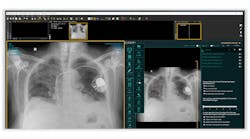The field of digital pathology is gaining momentum as more health systems, including Yale New Haven Health and WVU Medicine in West Virginia, announce plans for implementation on a large scale.
As a 2020 article in the Journal of Clinical Medicine noted, “digital pathology is on the verge of becoming a mainstream option for routine diagnostics. Faster whole slide image scanning has paved the way for this development, but implementation on a large scale is challenging on technical, logistical, and financial levels.”
Pathologists at WVU Medicine J.W. Ruby Memorial Hospital recently made digital pathology technologies part of their daily practice.
As a story on the WVU Medicine website explains, for more than 100 years, pathologists have examined tissue using a light microscope. With digital pathology, however, high-resolution images are created by scanning glass slides using sophisticated scanners designed specifically for this purpose. These images are reviewed by pathologists, who render their diagnosis without the need for a microscope. The pathologist can review these images anywhere within the WVU Medicine system and can share images with other pathologists and their clinical colleagues.
“This achievement was made possible through close collaboration between our IT team, WVU pathologists, our commercial partners, and many other University and Health System support staff,” said Peter Perrotta, M.D., pathology chair and system director of Pathology Services, in a statement. “Through digital pathology, we will add value to our clinical services while moving our pathology residency and other educational programs fully into the digital age.”
A story on the Yale New Haven Hospital (YNHH) website notes that the Connecticut-based health system will pilot the technology in the coming weeks before being expanded to other health system delivery networks.
“This is a significant investment that will enhance the quality and efficiency of patient care,” said pathologist Sudhir Perincheri, Ph.D., in a statement. “Digital pathology can allow for faster diagnoses, which means patients’ treatment plans can be implemented sooner.”
YNHH has purchased two high-volume scanners and software to view and/or analyze the digital files. In addition, Yale New Haven’s Clinical Imaging team and Information Technology Services department have developed systems for storing, labeling and accessing the digital files. Storage is a particular challenge, the story notes. Each slide yields a digital file that’s 300 to 400 megabytes; YNHH’s Pathology department produces 1,000 slides per day on average.
The story adds that storage needs, development of the scanning and reading technology and equipment cost are among the reasons it has taken pathology a while to go digital. But it quotes Chen Liu, M.D., Ph.D., chair and Anthony N. Brady Professor of Pathology at the Yale School of Medicine, and YNHH chief of pathology, as saying the investment will pay off because YNHH will be able to scan the slides it receives from other hospitals for pathology consults and have an easily accessible record if the patients end up at YNHH. That will be particularly beneficial during Tumor Boards, when physicians from different specialties meet to review patients’ cases and develop treatment plans.
Atlanta-based Emory Healthcare, with nearly 24,000 employees and 11 hospital campuses, has recently signed an agreement to add the digital pathology module to the Sectra enterprise imaging solution it deploys. This will provide the pathologists with diagnostic quality viewing and analysis of pathology studies digitally, as well as enable integrated diagnostics.
The pathology contract, signed during the third quarter of Sectra's 2021/2022 fiscal year, is an addition to the enterprise imaging contract signed in February 2021. The pathology module will be fully compatible with the Sectra radiology module and allow for enhanced training of residents and fellows as well as collaborative tumor board meetings.
"The synergies offered from a single enterprise imaging platform are substantial and side-by-side access to both radiology and digital pathology images, on the same viewer, is a game-changer in patient care," says Isaac Zaworski, president of Sectra, in a statement.
In an October 2021 interview with Pathology News, Mark Zarella, Ph.D., described his work as director of digital pathology at Johns Hopkins Medicine in Baltimore. “We are growing our scanning considerably at the moment with investments from the hospital,” he said. “We are currently engaged in increasing our scanning of consults by 100-fold. We get a lot a lot of consults, but also a lot of patients are coming to us from other hospitals, and keeping a digital copy of the slides is very useful for a number of reasons. We are also currently focusing on building large digital slide research repositories, with the idea that we can build AI tools or some sort of analytics that will help us with a lot of different research questions,” Zarella told Pathology News. “Building a data set like this from the ground up leads to a lot of possibilities. Those have been my focus areas from early on, increasing our scanning, building these research repositories and we want then to link these repositories through interfaces with some efficient methods of annotation.”


